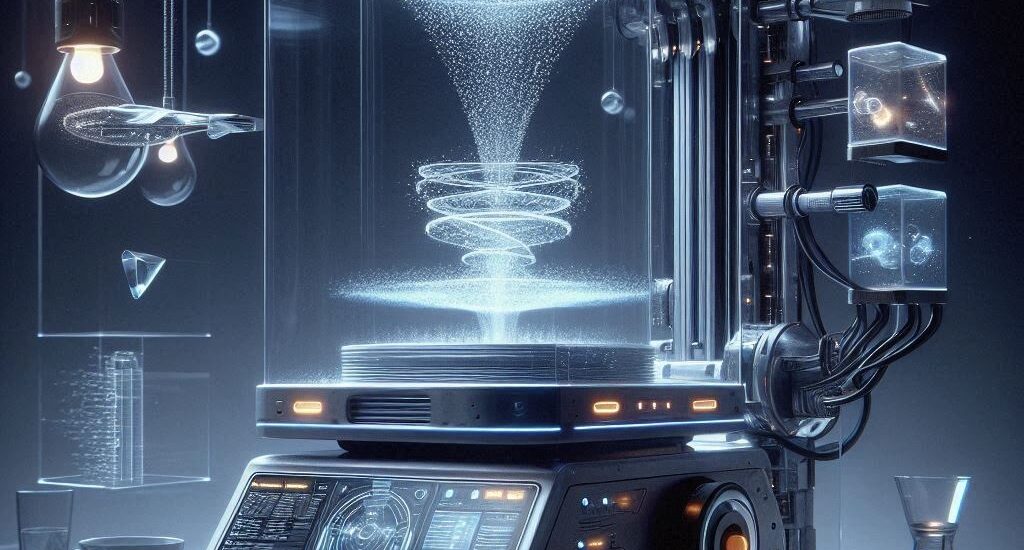Replicator technology has taken a big leap closer to science fiction, allowing you to create entire objects in just minutes. Unlike traditional 3D printing that builds layer by layer, this new method uses light and a rotating gel to form shapes instantly, almost like magic before your eyes. Whether you’re fascinated by futuristic gadgets or love quick creativity, this innovation could change how you think about making things, turning complex designs into real objects faster than ever.
The Breakthrough Technology Behind Rapid Object Creation
You’re witnessing a leap beyond traditional 3D printing that layers materials bit by bit. This new technique uses precisely controlled light patterns projected through a rotating vial filled with photosensitive gel, causing specific regions to solidify simultaneously. Unlike slow, layer-by-layer builds, the method completes complex shapes in mere minutes, enabling rapid production of detailed, centimeter-scale objects. It borrows from radiation targeting tech originally designed for cancer treatment, directing photons so their energies converge only where solidification is desired. The result: fully formed objects appearing almost instantaneously within the gel.
Phased Photon Delivery: How It Works
Your computer-controlled projector shines sequences of 2D images through the rotating vial, each from different angles. Photons traveling through the gel overlap at calculated points, their combined energy triggering the gel’s hardening reaction precisely where you want solid structures. Areas without overlapping photons remain untouched, allowing the gel to stay liquid. This synchronized photon convergence is what enables rapid, volumetric printing, producing entire 3D forms in a single continuous exposure instead of traditional slow stacking.
The Role of Photosensitive Gel in the Process
The specialized gel inside the vial reacts only when overlapping photons deliver enough combined energy in specific spots. This photosensitivity lets you control which regions solidify instantly, leaving the rest as liquid. Its unique chemistry responds to light dose thresholds, enabling clear definition of intricate shapes without the mess of partial curing elsewhere.
This gel’s composition is finely tuned to balance sensitivity and stability. It contains photoinitiators that activate polymerization only where photon energies converge, ensuring crisp edges and smooth surfaces. You get high-resolution details in objects like a miniature Thinker sculpture, all formed in minutes. Plus, because only targeted areas solidify, you can pause or adjust your design mid-build without ruining the gel, making iterative prototyping fast and straightforward.
Speed and Complexity: Redefining 3D Printing
This breakthrough replaces the slow, layer-by-layer approach with a burst of precision light, producing objects fully formed in minutes rather than hours. You can watch intricate shapes, like Rodin’s The Thinker, emerge seamlessly from a rotating vial, revealing fine details that would normally take long print times. The technology’s ability to control where light energy converges lets you create highly complex geometries in a fraction of the usual time, pushing the limits of what rapid prototyping can achieve.
Minutes to Reality: Creating Detailed Structures
By projecting carefully crafted 2D images through the rotating photosensitive gel, you get objects solidifying exactly where photon beams meet. This pinpoints the solidification process, enabling the creation of detailed, centimeter-scale models with complex features within minutes. Unlike standard 3D printers that stack layers, this method forms the entire structure simultaneously, greatly speeding up production without sacrificing precision or resolution.
The Versatility of New 3D Printing Applications
You’re not limited to stand-alone objects; this technology adapts to print around existing items, like adding a plastic handle directly onto a metal screwdriver shaft. It’s also ideal for encasing delicate electronics, protecting them with custom plastic shells formed in place. This flexible approach opens doors across industries, blending 3D printing with traditional manufacturing and electronics integration in ways not previously possible.
Expanding on its adaptability, the technique’s compatible photopolymer gels and precision light delivery mean you can tailor production to specific needs. For example, manufacturers could rapidly create protective housings custom-fit to any device, improving durability and function while cutting assembly time. Medical applications might include printing biocompatible structures snugly around implants or sensors. By integrating this rapid, customizable molding process, you gain new options for prototyping and manufacturing that combine speed, detail, and real-world utility seamlessly.
Beyond Replication: Innovative Uses in Various Fields
This rapid 3D printing method opens doors far beyond simple replication. By shaping complex forms in minutes and even molding directly onto existing objects, you gain new tools for customization, repair, and product design. Whether it’s creating artistic miniatures or functional prototypes, this technology streamlines workflows and enables creative experimentation that was once impossible under traditional layer-by-layer printing constraints.
Medical Applications: Encapsulating Electronics and More
Imagine embedding delicate medical sensors or electronics within biocompatible plastics without damaging them—this technique precisely builds protective structures around such components. It could improve implant safety, allow custom-fit prosthetics, or create shields for wearable health devices. The speed and accuracy reduce handling risks, offering a smarter approach to integrating technology with the human body.
Industrial Implications: New Possibilities for Manufacturing
You can envision drastically faster production lines with this technology, crafting ready-to-use parts in minutes rather than hours or days. Producing complex components without assembly steps cuts costs and accelerates innovation cycles. The ability to form parts around existing elements adds versatility for repairs, retrofits, or hybrid manufacturing processes that blend traditional and additive methods.
In practical terms, industries like automotive and aerospace stand to benefit greatly. For example, small-batch custom components or rapid tooling inserts could be fabricated on demand, enabling quicker iterations during design and testing. Also, because the process solidifies entire objects simultaneously, complex internal structures or embedded channels become feasible without complicated post-processing. This technology could shift manufacturing toward more sustainable practices by minimizing waste and reducing the need for inventory storage.
Impacts on Everyday Life: What This Means for Consumers
You’ll soon find that making complex, custom objects can become as easy as pressing a button. Instead of waiting hours for traditional 3D printers to build layer by layer, this new method delivers fully formed items in mere minutes. Whether you want a replacement part, a gift, or a prototype, the technology’s speed and precision can dramatically simplify your creative and repair projects. Plus, the ability to print around existing objects opens up new ways to enhance everyday tools and devices right at home.
Reducing Waste and Improving Efficiency
This technology focuses energy precisely where it’s needed, solidifying material only in the exact spots that form your design. Unlike process-heavy manufacturing, it cuts down on leftover plastic or resin, resulting in much less waste. Rapid build times also reduce energy consumption linked to extended print jobs. For consumers like you, this means faster results with fewer resources used—less clutter, less cost, and a smaller ecological footprint from your home projects and custom creations.
The Future of Customization in Products
Imagine tailoring objects exactly to your needs without relying on mass production. This technique lets you create complex, one-off designs or rapid prototypes faster than ever before. You could personalize tools, accessories, or even functional parts on demand, adjusting shapes and sizes precisely. The pinpoint control over solidification means intricate details and embedded components become more feasible, pushing customization into everyday reach.
Take eyewear, for example: you might print frames that perfectly fit your face, with built-in lenses and ergonomic grips made in a single, continuous build. Or consider baking molds shaped to your favorite designs or smartphone cases customized with your artwork intertwined into the plastic. The technology also opens doors for small businesses and hobbyists to innovate without huge upfront costs or waiting times. As the process matures, the ease of creating bespoke items tailored to your lifestyle will expand beyond novelty to everyday practicality.
Ethical Considerations: The Challenges Ahead
The speed and precision of this new 3D printing method bring up ethical questions about regulation, safety, and responsible use. You might wonder how easy it could become to replicate restricted or dangerous items with such rapid production. Balancing innovation with potential misuse means policymakers and users will need to establish clear guidelines that protect both creators’ rights and public safety as this technology becomes more widespread.
Intellectual Property Issues with Rapid Production
When objects can be produced in minutes from digital files, protecting designs becomes tricky. You might find it harder to control unauthorized copies of your work, as files could be shared or altered before you even know it. Existing intellectual property laws may struggle to keep pace with this fast replication, pushing industries to rethink how they safeguard creations in an era where tangible objects can seemingly appear out of thin air.
The Environmental Impact of New Printing Technologies
Rapid 3D printing offers efficiency but also raises questions about resource use and waste. You may be surprised that while speeding up production, this tech could reduce energy consumption compared to traditional layer-by-layer printing. However, the materials used, especially specialized photosensitive gels and plastics, require careful consideration to avoid generating hazardous waste or pollution.
Diving deeper, the environmental footprint of this technology involves both material input and energy output. For example, the photosensitive gels rely on synthetic polymers that might not be biodegradable, posing disposal challenges if produced at scale. On the energy side, the precise light delivery reduces unnecessary curing steps, slashing some of the power typically needed for additive manufacturing. Yet, large-scale adoption demands evaluating lifecycle impacts, recycling possibilities, and the sourcing of raw materials to truly ensure this rapid replicating method aligns with greener manufacturing goals you care about.
Finally
Summing up, this Star Trek–like replicator technology lets you create entire objects in mere minutes by projecting precise light patterns into a rotating photosensitive gel. Unlike traditional 3D printing that builds layer by layer over hours, this method instantly solidifies parts of the gel where light meets, bringing your designs to life quickly and with great detail. Whether you want to duplicate intricate sculptures or add plastic parts onto existing items, this innovation opens exciting possibilities for your creative projects and everyday needs.









